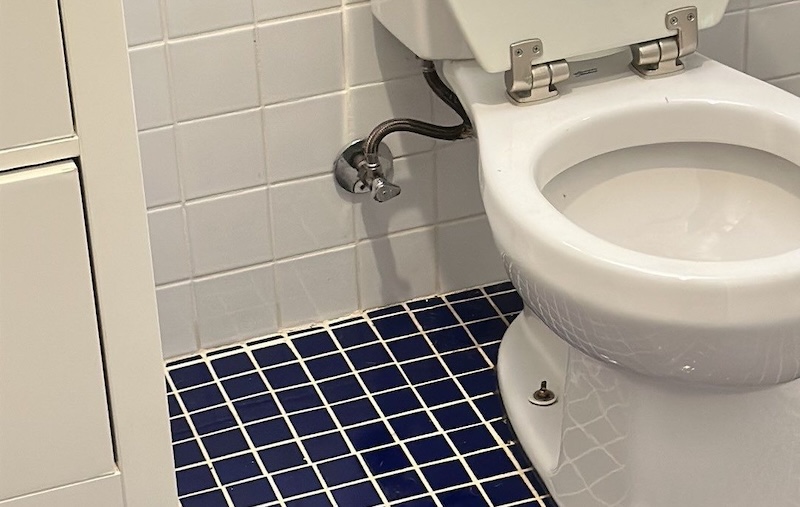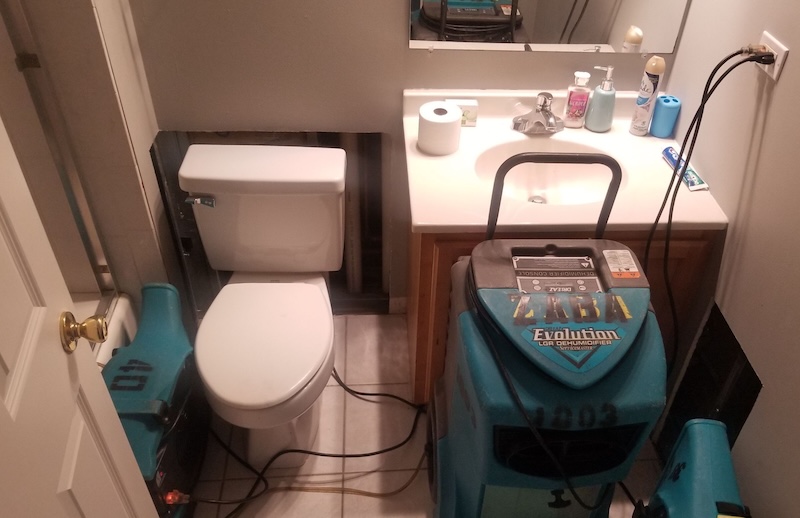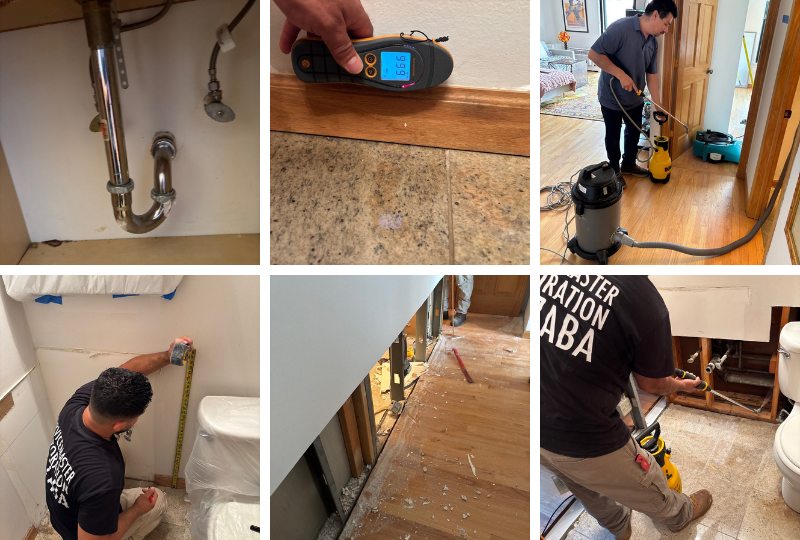Even a small bathroom supply line leak under the sink, behind the toilet, or around the faucet can quickly cause major water damage and mold if not fixed immediately.
Each day at ServiceMaster Restoration by Zaba, we help Chicago homeowners restore their property after water damage from hidden leaks.
Here’s how to spot a supply leak in the bathroom, stop it fast, and avoid costly repairs.
Key Takeaways
- If there’s a bathroom supply line leak, shut off the water immediately, locate the source, and gather basic tools like towels, a wrench, and a bucket before starting any repairs.
- To fix the leak, tighten loose fittings, replace damaged hoses or gaskets, reseal faucet bases, and dry any damp areas with fans or a dehumidifier.
- If you find or suspect water damage, call ServiceMaster Restoration by Zaba at (773) 647-1985 to restore your property to its pre-loss condition.
Before You Get Started

1. Locate the Leak
Start by finding where the water is coming from. Focus on these common trouble spots:
- Under the sink: Check hot and cold water supply hoses, shut-off valves, and faucet connections.
- Behind the toilet: Look at the supply line to the fill valve and around the shut-off valve.
- Around the faucet base: Look for pooled water or seepage around handles or where the faucet meets the sink. Run your hand along hoses and fittings to feel for moisture – a damp spot might be your leak source.
2. Shut Off the Water
- Turn the shut-off valve under the sink or behind the toilet to stop the flow.
- If the valve doesn’t work or the leak continues, turn off your home’s main water supply.
3. Gather Basic Tools
You don’t need a full toolbox, but having the right items on hand helps you handle small plumbing repairs:
- Adjustable wrench or pliers
- Towels or rags to soak up water
- Bucket (for any remaining drips)
- Flashlight to see under cabinets
- Plumber’s tape
- Replacement supply line, gaskets, or O-rings (if needed)
How to Fix a Bathroom Supply Leak: Step-by-Step

1. Tighten Connections
Loose or aging connections cause most leaks. Use a wrench to tighten compression nuts or threaded fittings gently.
Don’t overtighten – this can crack plastic parts or strip metal threads.
Pro Tip: Place a towel below the area before working to catch any drips and protect cabinets.
2. Replace Damaged Parts
- Supply hoses: If the hose is cracked, bulging, or leaking, shut off the water and replace it with a braided stainless-steel hose. These last longer and resist twisting or crimping.
- Leaky valve: Remove the valve stem, inspect the rubber washer or gasket, and replace worn parts. Use plumber’s tape when reassembling threaded parts to help seal.
- Faucet leaks: Remove the faucet handle, pull out the cartridge or stem, and replace worn gaskets or O-rings. If unsure, bring the part to a hardware store for a match.
- Sealant: Remove old caulk around the faucet base and apply new waterproof caulk to prevent seepage.
Pro Tip: When reinstalling supply lines or valves, dry all fittings with a towel and check again after turning the water back on. Run a paper towel along the connection to detect any hidden slow drips.
3. Inspect for Water Damage
If the leak has gone unnoticed for more than a day or two:
- Check cabinet floors for swelling, soft spots, or water stains.
- Inspect baseboards, drywall, and nearby flooring for bubbling, warping, or discoloration.
- Check adjacent rooms for damp carpet, musty smells, or warped wood.
Pro Tip: Use fans or a dehumidifier to dry out damp areas quickly. If water has soaked into drywall or flooring, call a water damage restoration professional to prevent mold.
4. Call a Plumber and Water Damage Restoration Contractor
If you can’t find the source of the leak or the shut-off valve fails, call a licensed plumber to handle the repair safely.
If there’s visible water damage, bring in a local, Chicago-based restoration contractor like ServiceMaster Restoration by Zaba to dry, clean, and restore the affected areas properly.
We use moisture meters and thermal cameras to detect hidden water, then dry, clean, and restore your Chicago home.
Prevent Bathroom Supply Leaks Before They Start
- Inspect supply lines and shut-off valves twice a year.
- Replace supply line hoses, such as washing machine hoses, every 3-5 years, even if they look fine.
- Turn shut-off valves on and off occasionally to keep them from sticking.
- Install leak detectors under sinks and behind toilets for early warnings.
Real Results: How We Restored a Lakeview Home After a Bathroom Supply Leak

A Lakeview homeowner discovered a bathroom supply line leak that caused Category 2, Class 2 water damage throughout multiple rooms.
Our team arrived immediately, contained the leak, and began mitigation to stop further damage.
Here’s how we restored each affected area:
- Bathroom (Source Room): We moved contents out of the work area, installed plastic protection, and removed the baseboards. Our technicians made two-foot flood cuts in the drywall and detached the vanity and sink for full access. They vacuumed, cleaned, and sanitized the floors and exposed stud walls, then set up two air movers to dry the space.
- Hallway: We removed partial baseboards and drywall, made two-foot flood cuts, and cleaned and sanitized all surfaces. Our crew installed two air movers, one dehumidifier, and a wood drying system to extract hidden moisture from the subfloor.
- Bedroom: Our team protected contents, removed partial baseboards and drywall, and completed two-foot flood cuts. They vacuumed, cleaned, and sanitized the affected area, then placed two air movers to maintain steady airflow for drying.
- Living Room: We relocated contents, added plastic protection, and removed partial baseboards and four linear feet of drywall. After vacuuming, cleaning, and sanitizing, we installed one air mover to dry the remaining moisture.
We completed the drying process in just four days.
By acting quickly and applying controlled drying methods, we stabilized moisture levels, prevented mold growth, and restored the Lakeview home to its pre-loss condition.
Dealing With a Bathroom Supply Line Leak in Chicago? We Can Help.
If a bathroom supply line has flooded your cabinet, soaked your drywall, or warped your floor, don’t wait.
ServiceMaster Restoration by Zaba is available 24/7 to restore water-damaged bathrooms across Chicago and the suburbs.
Call us at (773) 647-1985 for immediate assessment.
FAQs
What causes bathroom supply lines to leak?
Common causes include worn-out washers, cracked hoses, corroded fittings, or loose connections. High water pressure can also contribute to leaks over time.
How do I know if the leak is behind the wall?
Signs include bubbling paint, musty odors, mold, or water stains on nearby walls or ceilings. If in doubt, call a plumber or restoration expert to investigate.
Can I use plumber’s tape on supply lines?
Yes, plumber’s tape (Teflon tape) can help seal threaded connections, especially when replacing fittings or valves.
Is water damage from a bathroom leak covered by insurance?
Most homeowners insurance policies cover sudden and accidental leaks. Gradual leaks or neglect may not be covered. Always document the damage and call your insurer promptly.
How long does water damage restoration take?
Drying usually takes 3-5 days. Full restoration can take 1-2 weeks, depending on the extent of the damage.